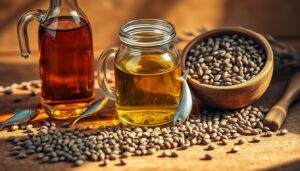Are too many Omega-6 fatty acids problematic for humans?
Imagine you were born in 1909. At that time, the average person had just 1kg of omega-6 fats per year – so it's a tiny pile, so to speak.
Let's jump to 1987: Consumption is on the rise 12kg . And today?
In 2025 we are already at a whopping 36kg Omega-6 per year . It's like a small bathtub filled with vegetable oils!
So it's no wonder that our body sometimes cries out "Help!" at such quantities. After all, there is often a blatant imbalance between omega-6 and omega-3. We need both fatty acids, but in moderation and in a healthy ratio.
95% are out of balance!
Why can too much omega-6 problematic?
Omega-6 is not a bad thing per se - it is one of the essential fatty acids that our body cannot produce itself.
But: If it comes in in too large quantities, while at the same time there is too little omega-3 on board, this can increase the inflammatory potential in our body.
According to 1,500,000 tests, 95% of people worldwide are out of balance with a ratio of 15:1 instead of 3:1.
The most severely affected are Children .
If you look at it holistically, your body is a unit of physical, mental and spiritual processes. Any disturbance of the balance, e.g. due to too much fatty acid, can affect our energy and vitality in the long term.
The following foods are real
Omega-6 bombs
If you're wondering: "Where is all the omega-6 actually in it?", here are a few "bangers":
- 1Sunflower: 50 : 1 (Omega-6 : Omega-3)
- 2Amaranth: 50 : 1
- 3Cashew nuts: 49 : 1
- 4Almonds: 48 : 1
- 5Corn: 40 : 1
- 6Oats: 27 : 1
- 7Rice: 26 : 1
- 8Chickpeas: 20 : 1
- 9Millet, wheat, spelt: 15 : 1
Yes, you read that right: Some of these grains and nuts sound super healthy – and they also have good minerals, vitamins, etc. But their omega-6 content is really high. It is best to mix these foods wisely with omega-3-rich products (such as fatty fish, flaxseed or chia seeds).
Oils in comparison: Safflower oil or linseed oil?
The oils also often contain more omega-6 than we would like. The ratio can easily crack the 100:1 mark here. Look:
- 1Safflower oil: 159 : 1
- 2Sunflower oil: 126 : 1
- 3Pumpkin seed oil: 120 : 1
- 4Corn oil: 57 : 1
- 5Olive oil: 8 : 1
- 6Hemp oil: 3 : 1
- 7Rapeseed oil: 2,3 : 1
- 8Linseed oil: approx. 0.27 : 1 (so it is rather omega-3-heavy)
If you're wondering how it can be that you take in so much omega-6 without realizing it: It happens almost incidentally, for example when you use sunflower oil for frying. Imagine frying your food in sunflower or safflower oil for years. You can quickly slip into the range of the above-mentioned 36 kg/year.
Where else is omega-6 hiding?
In addition to oils and seeds, you will find omega-6 in many processed foods , to which cheap vegetable oil is added. These are, for example:
And often even vegan ready-to-eat products, which are supposed to be healthy, rely on omega-6-rich raw materials. The following applies here: Always look at the label, because just because it says "vegan" doesn't mean it's healthy. The more unprocessed, the better!
How do they work Does high amounts of omega-6 affect the body?
Excess omega-6 can influence the formation of so-called eicosanoids, which can promote inflammatory reactions. Although the body needs omega-6 as a building material for various processes, the natural balance of fatty acids begins to falter in excess.
Why balance is important (Omega-6 to Omega-3)
Our body doesn't like it too one-sided. Omega-3 fatty acids (e.g. in linseed oil, salmon or algae oil) have more of an anti-inflammatory effect, while an excess of omega-6 can fuel inflammatory processes.
The point is: We need both , but in a reasonable proportion. Think of it as a yin-yang principle for fatty acids.
Simple everyday tips to reduce omega-6
- 1Oil change: Replace sunflower or safflower oil more often with high-quality rapeseed oil or olive oil. For cold dishes, it can also be linseed oil.
- 2Mix & Match: If you're in the mood for cashews or almonds, incorporate good sources of omega-3 (flaxseed, chia seeds, fatty fish) at the same time.
- 3Cook yourself: Fried and ready-made foods are often true omega-6 carriers. With homemade you know exactly what oil is in it.
- 4Focus on fish or algae oil: For example, salmon, herring or mackerel from sustainable wild-caught fish once or twice a week. This brings you closer to a better balance again.
Without a targeted supply, you are unlikely to be able to balance your values !
The most important thing ? Check your values and get tested.
According to 1.5 million tests worldwide, 95% of people are severely out of balance.
Zinzino offers a holistic concept of neutral tests and scientific solutions. They have been researching for 20 years and have developed a unique concept.
The best: If your values are already good - you get your money back!
ZINZINO – The concept behind it
If you notice that your omega-6:3 ratio is rather unbalanced and you don't want to completely turn your everyday life upside down, a Omega-3 supplement help.
At this point, ZINZINO into the game:
What exactly is Zinzino BalanceOil?
Our video explains everything to you:
The scientifically proven solution:

🌿 Effectiveness:
💜 CUSTOMER SATISFACTION:
Money Back
100%
Warranty
If your values are already in the positive range at the first test, i.e. if you have a balanced omega 6 to 3 ratio of 3:1 or better, you will get your money back without ifs and buts!
If your values are already good - you don't pay anything!
If your test value is already in the ideal range:
No risk. No discussion. No catch.
How to find the right ratio from omega-6 to omega-3
The good news: A good omega-6:3 ratio is achievable without having to completely forego enjoyment. In addition to conscious product choice, sensible additions are also important.
- 1Use high-quality oils
– Olive oil, rapeseed oil or linseed oil contain more omega-3 (linseed oil) and fewer pro-inflammatory omega-6 fatty acids than typical "cheap oils". - 2Oily fish from wild catch
– Salmon, herring, mackerel and anchovies provide marine omega-3 (EPA and DHA) in high concentrations.
– As a plant-based alternative: High-quality algae oils with sufficient amounts of EPA and DHA. - 3Cut back on industrial snacks
– It is better to prepare chips, fries and the like yourself and use more suitable fats in moderation. - 4Pay attention to the overall concept
– A balanced diet with fresh vegetables, fruit and sufficient whole grain products creates the basis.
– Frequent reading of ingredient lists helps to unmask hidden omega-6 traps
Short & Sweet – Your to-do list
Stay in your center ,listen to your body – and use the knowledge of omega-6 and omega-3 to improve your Strengthen your health and well-being.
Like ZINZINO BalanceOil+ can help
To bring the omega 6:3 ratio into a healthy range, many people have had good experiences with Zinzino products. BalanceOil+ for example, fish oil (or algae oil in the vegan version) is combined with a high polyphenol content made from extra virgin olive oil. These polyphenols increase the stability of omega-3 fatty acids and ensure that they are better absorbed by the body [cf. Mateos et al. (2005) and internal product data of the manufacturer].
- 1Individual analysis
– A simple dry blood test (DBS) can be used to determine your current ratio of omega-6 to omega-3.
– This allows you to see exactly if and how much you are affected by an imbalance. - 2Polyphenol protection
– Polyphenols from early-harvested olives help protect the delicate omega-3 fatty acids during digestion.
– This ensures higher bioavailability, so that the fatty acids actually arrive where they are needed. - 3Synergistic formula
– Fish oil plus olive oil polyphenols mean a significantly longer stability of omega-3 fatty acids in the body (approx. 35 hours), while conventional fish oil can disintegrate after about 10 hours.
– This allows the body to make better use of essential fats. - 4Sustainability and quality
– Zinzino relies on sustainably caught fish (including Friend of the Sea certified) and molecular purification to remove pollutants.
– A low TOTOX value and the stability gained prove the freshness and high quality of the oil.
All information about Zinzino
BalanceOil+
Consistent intake over several months (at least 120 days) has been proven to improve the ratio of omega-6 to omega-3. This "measure, do, measure" principle (dried blood test before and after ingestion) clearly shows how the fatty acid level in the blood normalizes.
Result
Foods high in omega-6 are ubiquitous in our society. But "omega-6 bombs" do not have to cause fear or annoyance if we are aware of things and actively take countermeasures. A careful reduction of ready meals, higher quality oils in the kitchen, more omega-3-rich food and – if necessary – intelligent supplementation can restore the balance.
ZINZINO shows a possible way here to bring the fatty acid level into balance based on the test. Supplemented by a holistic lifestyle (nutrition, exercise, relaxation) you will find step by step to a healthier you.
Money Back
100%
Warranty
If your values are already in the positive range at the first test, i.e. if you have a balanced omega 6 to 3 ratio of 3:1 or better, you will get your money back without ifs and buts!
If your values are already good - you don't pay anything!
If your test value is already in the ideal range:
No risk. No discussion. No catch.
Frequently Asked Questions
- 1Why is too much omega-6 unhealthy?
Too much omega-6 in combination with an omega-3 deficiency promotes inflammatory processes. Studies suggest that this imbalance can lead to chronic complaints in the long term. - 2Which nuts contain a lot of omega-6?
Nuts such as peanuts and walnuts have a relatively high omega-6 content, but also provide valuable nutrients. Pay attention to the overall concept of your diet and balance with other sources of omega-3 (e.g. fish, linseed oil, chia seeds). - 3Can I just avoid omega-6 completely?
No, omega-6 fatty acids are also essential. It's about the balance, not about total avoidance. - 4How does Zinzino help in concrete terms?
Zinzino offers a testing option and a specially formulated oil (BalanceOil+) that remains stable for longer due to polyphenols. This means that more omega-3 is absorbed by the body and the ratio of omega-6 to omega-3 is improved in the long term.
Sources & Further Links
- 1PubMed ID: 12480795 – Omega-3 fatty acids for inflammation and autoimmune diseases
- 2PubMed ID: 20564531 – Omega-3 fatty acids to maintain remission in Crohn's disease (example of inflammatory processes)
- 3Mateos et al. (2005). Antioxidant effect of olive oil polyphenols on oxidation of omega-3 fatty acids. Journal of Agricultural and Food Chemistry, 53(16), 6090-6099.
- 4Zinzinotest.com– Anonymous publication of the measurement results (dried blood tests)
Important: The links are for information purposes only, they do not constitute an explicit recommendation. Please note the privacy policy and imprint information on the respective websites.






